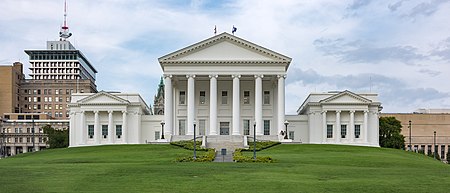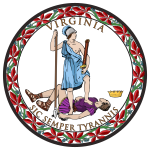Virginia State Capitol

The Virginia State Capitol is the seat of state government of the Commonwealth of Virginia, located in Richmond, the third capital city of the U.S. state of Virginia. (The first two were Jamestown and Williamsburg.) It houses the oldest elected legislative body in North America, the Virginia General Assembly, first established as the House of Burgesses in 1619. The Capitol was conceived of by Thomas Jefferson and Charles-Louis Clérisseau in France, based on the Maison Carrée in Nîmes. Construction began in 1785 and was completed in 1788. The current Capitol is the eighth built to serve as Virginia's statehouse, primarily due to fires during the Colonial period. In the early 20th century, two wings were added, leading to its present appearance. In 1960, it was designated a National Historic Landmark.
Excerpt from the Wikipedia article Virginia State Capitol (License: CC BY-SA 3.0, Authors, Images).Virginia State Capitol
Bank Street, Richmond Shockoe Slip
Geographical coordinates (GPS) Address Phone number Website External links Nearby Places Show on map
Geographical coordinates (GPS)
| Latitude | Longitude |
|---|---|
| N 37.538758 ° | E -77.433594 ° |
Address
Virginia State Capitol
Bank Street 1000
23219 Richmond, Shockoe Slip
Virginia, United States
Open on Google Maps










